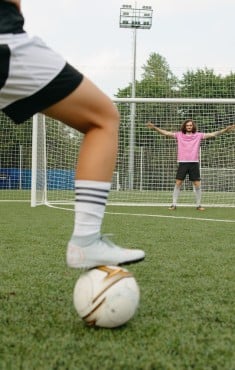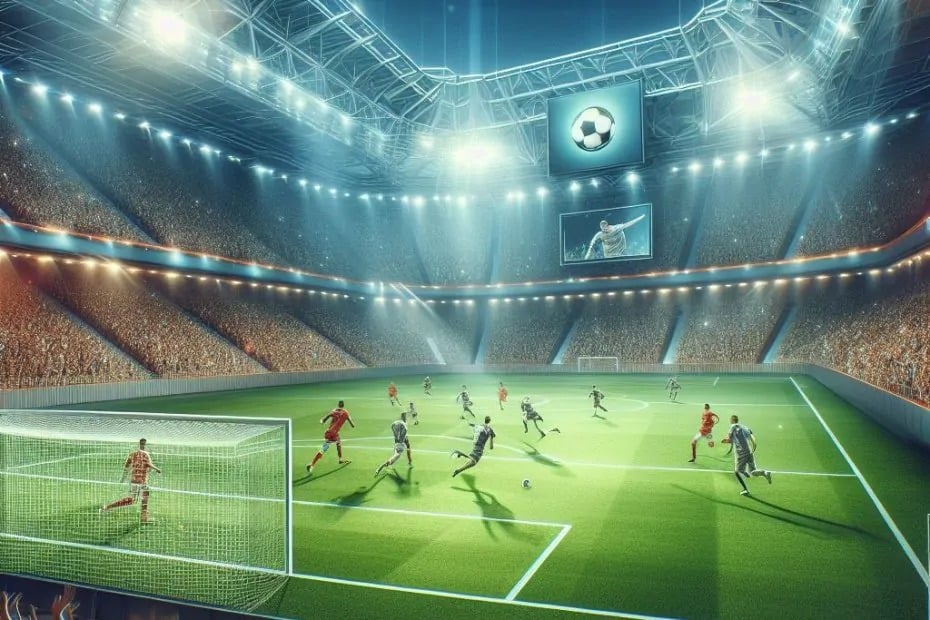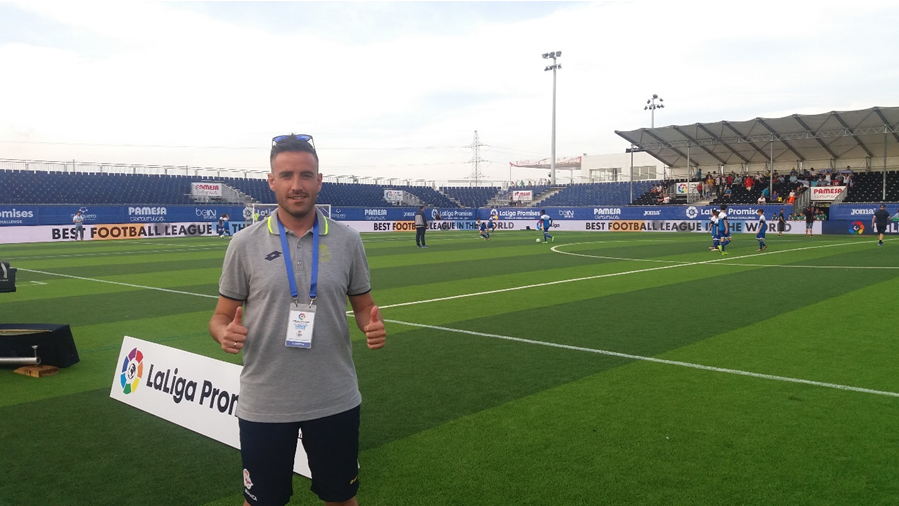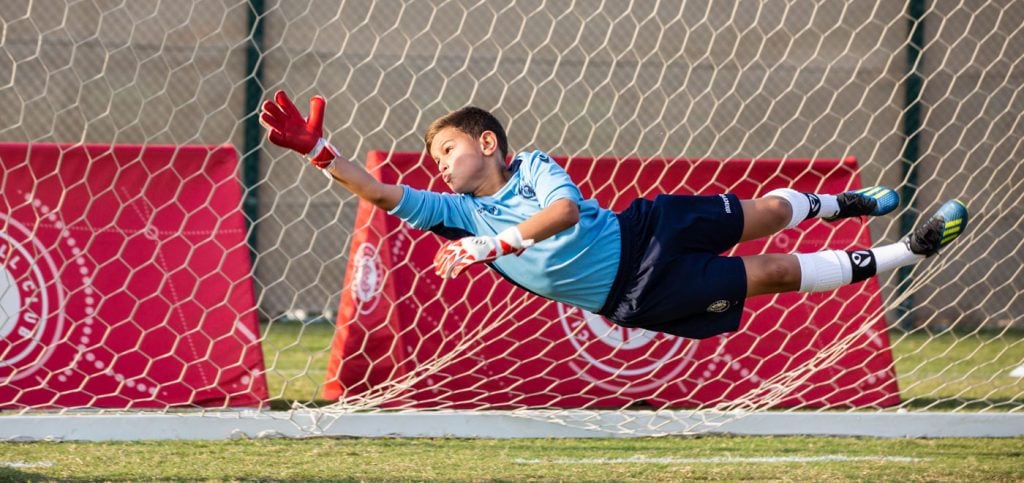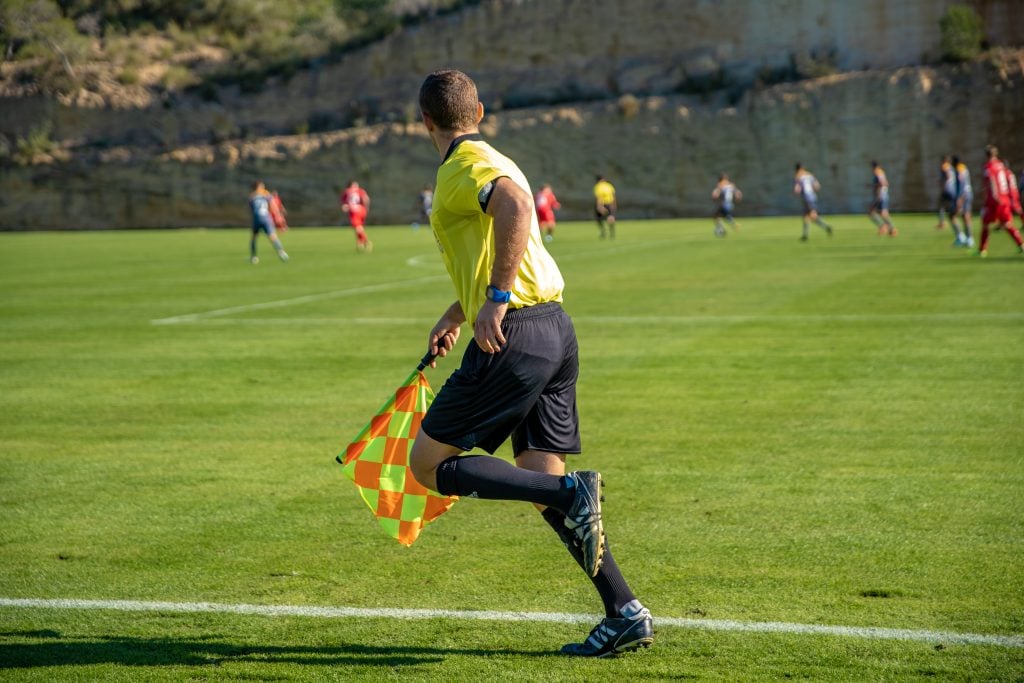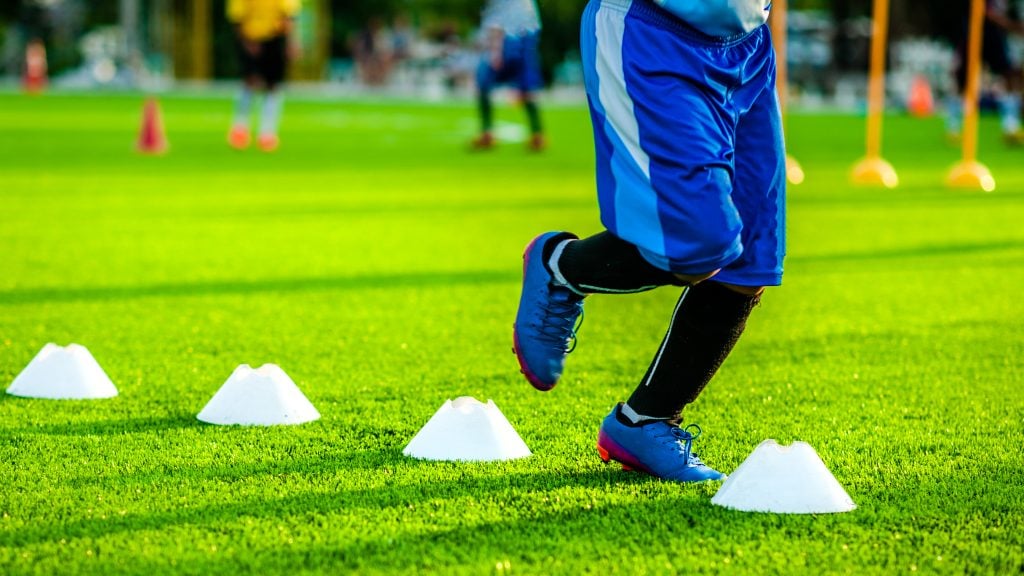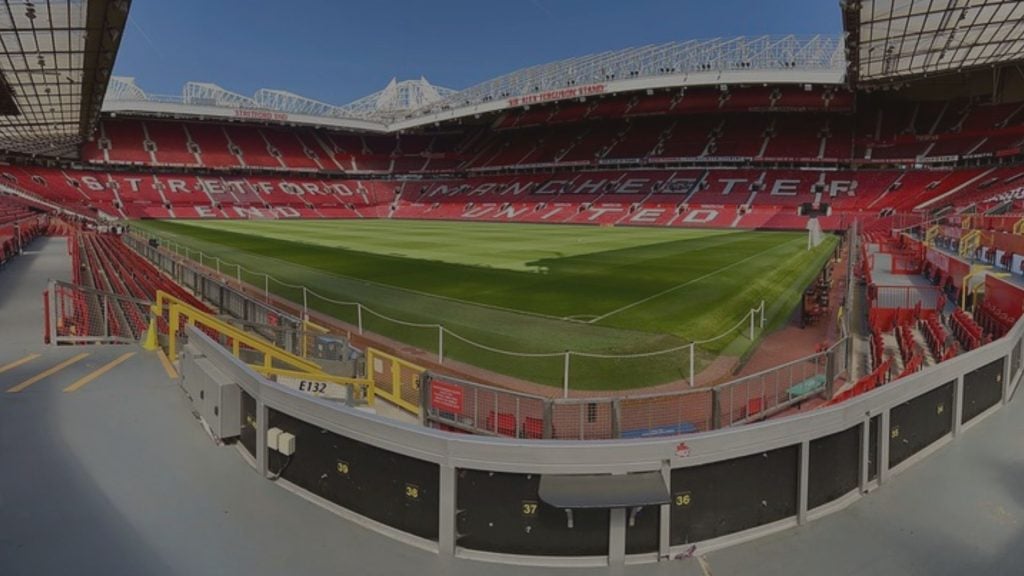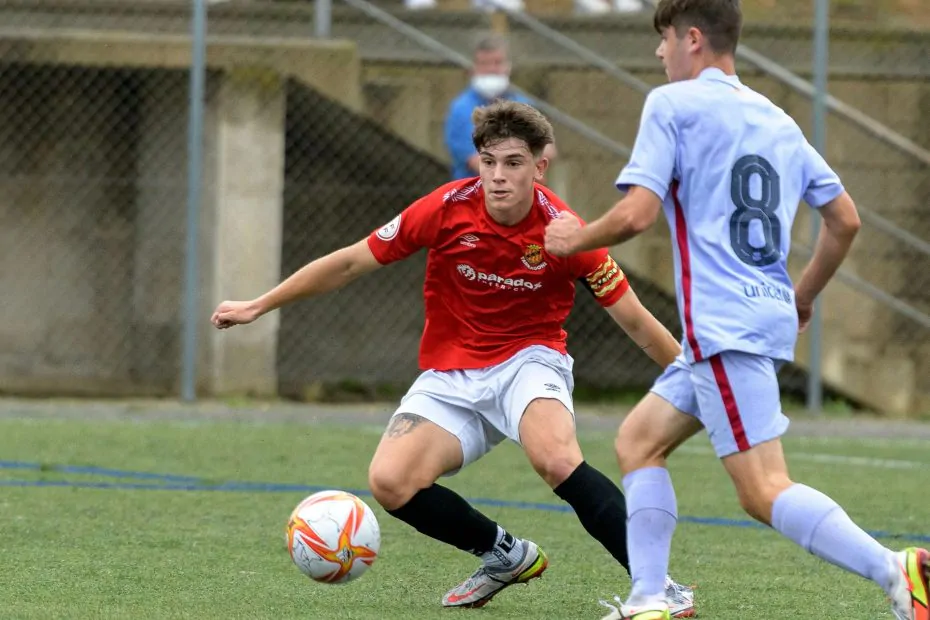In this article we present 32 football drills, which are suitable for players of all ages, to develop mastery of the four basic aspects of football: passing, shooting, defending, and dribbling.
Any dream pursued in life has its complications, its challenges, its difficulties. In fact, without them, dreams would probably be a little less of a dream. Some are achieved through perseverance, others through determination, or through patience. But in few, perhaps none, is work as important as in the dream par excellence of so many boys and girls: to be a professional footballer.
Because football, or that is our philosophy, is work. It is perseverance and training. It is the ability to do one’s best, not only as a mean to reach a goal, but as a path that one must learn to enjoy. In which, even if the ultimate objective is not achieved, the enjoyment, pride and satisfaction is there, in all those hours of work and improvement.
Training is, for us, both a mean and an end, something necessary but also fun. So here we bring you the 20 basic football drills for the development of a footballer. So that you, either you are a player or a coach, can use them at any time, and you can follow our philosophy on your own.
Some of them are drills that we put into practice in many of our summer football camps and football schools around the world, others we have compiled specifically for this article.
In any case, we divide them into four branches, covering the most important technical concepts both in attack and defense.
- Dribbling and ball control
- Shooting
- Passing
- Defensive concepts
We can also highly recommend our online football/soocer course course if you want to get ahead in your drills with UEFA PRO Coach Pablo Huerga.

Drill key
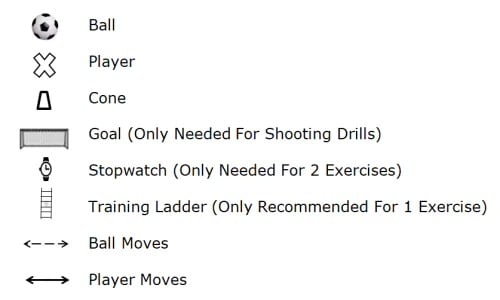
Top 9 exercises for dribbling and ball control
We see less and less on the football pitch the “canchero” player, as they call him in Argentina. The one who faces the ball, doesn’t cut himself off and throws a bicycle kick, a dribble, or a back-heel. That football of the street, which we often believe has been lost with the arrival of the academic model. Although we don’t agree, absolutely not. Because even in a school you can learn to play as if you spent days and nights on a pitch in Rio de Janeiro, and here we bring you some exercises for that purpose.
Dribbling skills are extremely important for maintaining ball possession, especially in crowded areas on the pitch like in the center of the field, near your own goal, or near the opposing goal. A player with good dribbling skills can move the ball in different directions at different speeds with both feet. They can successfully maneuver through opponents without losing possession of the ball.
These soccer dribbling drills were designed to improve your dribbling skills in crowded areas, your dribbling speed for breakaways and less crowded areas, and your ability to change direction with the ball.
Dribbling: one on one
No one will deny that Neymar Jr. is, now, the player with the best ball handling in the world. His dribbling is fabulous, his control of the ball is out of this world, as if it were stuck to his boot. Is there a way to achieve such technical quality, or is that only possible with basic conditions within the reach of very few?
Becoming Neymar is very difficult, that’s for sure, but being a wide player, a winger with the ability to face his defender, is possible with hard work. A basic and simple exercise for this is to define a space and carry out a series of one-on-ones between two players. The learning process is twofold: not only do you learn how to face and dribble, gaining resources for one-on-one play, but also how to defend these situations. And the best thing is that it is very fun, very competitive.
This video by Jonathan Mendoza is a great way to apply this exercise in groups as small as one of two people: all you need is an attacker, a defender, a small, delimited goal to attack and, if there are more than two players, take turns.
➔ Exercise level: Easy
➔ Fun rating: 4/5
➔ Number of players needed: 2, at least.
➔ Equipment needed: Ball and objects of any kind to mark out a goal.
Simple exercise with cones
But of course, it is not always all about group exercises. In football, certain qualities can also be worked on individually, and handling, or dealing with the ball, is something that a player can work on individually. Moreover, it should be noted that this is increasingly necessary, and for all positions in a football team: as we are seeing in this World Cup 2022, even goalkeepers like Unai Simón must have an excellent way of dealing with the ball, handling the different contact surfaces on the foot.
A good way to improve your ball handling is to dribble through cones set up in an enclosed space. A great example is this video exercise from BetterSoccerDrills, which explores different ways of dribbling and can be carried out almost anywhere.
➔ Exercise level: Easy
➔ Fun rating: 2/5
➔ Number of players needed: 1
➔ Equipment needed: Ball and cones
Of course, if you must choose a current player to use as a model for this exercise -and almost any other-, it can only be Lionel Messi. Here is a video of one of his best drives of all time: against Athletic Bilbao in the final of the Spanish Copa del Rey, in which he runs through players as if they were cones.
Lionel Messi ● 10 Greatest Solo Runs Ever ► Box to Box / Midfield to Box ||HD||
If you want to, like he did, learn to play like at La Masia, check out this FC Barcelona summer camp.
Advanced exercise with cones
This group of exercises from Become Elite makes the previous cones exercise a little more complex and creates different spaces with cones in which the ball must be moved at different speeds. The positive side in comparison to the previous one, in addition to its greater complexity, is that it also serves to work on physical toning and endurance if carried out at a high pace, or by applying changes in intensity.
➔ Exercise level: Medium
➔ Fun rating: 3/5
➔ Number of players required: 1
➔ Equipment needed: Ball and cones
Perhaps, if one had to look for another example of a mythical goal carried out after a slalom, involving changes of pace and direction of all kinds, the perfect example is Ronaldo’s (the Brazilian) goal against Compostela, back in 1996. A real wonder. Again: the players on the pitch resemble cones.
Cone circle
Another simple way to perform individual exercises with cones for ball control is to work in a circle. This video from OnlineSoccerTraining shows how footballers of any age can do this. The best thing is that it represents a more realistic playing situation than the first exercise with cones, as the driving is not as linear.
➔ Level of the exercise: Easy
➔ Fun rating: 3/5
➔ Number of players needed: 1
➔ Equipment needed: Ball and cones
Here we turn to another Brazilian wizard, Ronaldo’s successor, and Neymar’s predecessor: Marta, probably the best female footballer in history. Enjoy this video.
El recorte
Spanish football, less prolific than South American football in terms of the magic of dribbling, nevertheless has its own movement: the cut-back, a dribble in which the change of foot and rhythm is used above all, the feint with the body, to slip away from one or more opponents. Here is an exercise explained by Andrés Iniesta himself, one of the most brilliant magicians European football has ever produced. A legend of Barça and the Spanish national team, he mastered like no other the art of “la croqueta”, a cutback in which he used both feet.
Of course, if you want to do it individually, you can replace the opponents with cones to practise “la croqueta” move.
➔ Level of exercise: Easy
➔ Fun rating: 3’5/5
➔ Number of players needed: 1
➔ Equipment needed: Ball and cones
More Dribbling Drills to practice alone or with a friend
Cone drill
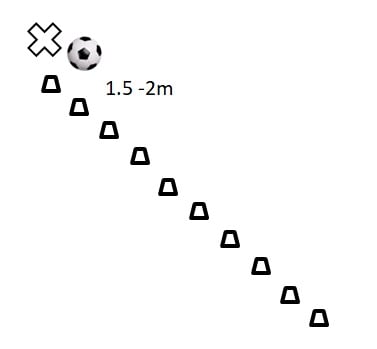
➔ Recommended equipment: 1 ball, 10 or more cones
➔ Number of players required: 1 player
➔ Set-up: Line up at least 10 cones 1.5 – 2 meters apart
➔ Exercise: Players practice dribbling through the cones with the inside of both feet, outside of both feet; inside and outside of the right foot; inside and outside of the left foot; practice roll-overs, scissor kicks, etc.
➔ Purpose: Practice ball control and touch
*Optional modification – Add a final cone 20 meters away from the other cones. When finished dribbling through the cones, sprint to the final cone with the ball at your feet for extra practice breaking away from defenders while maintaining control.
Variations: Soccer Drills Daily
Suicide dribbling

➔ Recommended equipment: 1 ball, 5 or more cones
➔ Number of players required: 1 player
➔ Set-up: Line up at least 5 cones 5 meters apart
➔ Exercise: Starting at Cone 1, sprint with the ball to Cone 2. Turn and sprint back to Cone 1. Turn and sprint to Cone 3, back to Cone 1, and so on.
Once you have reached all four cones and are back at Cone 1, take a 30 second rest before starting the next set.
➔ Purpose: With this soccer dribbling drill, practice dribbling with speed and control; improve physical fitness; practice turns and changing direction.
Source: Soccer Maniak
1v1 controlled scoring
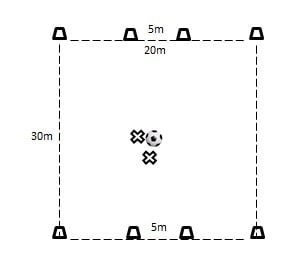
➔ Recommended equipment: 1 ball, 8 cones
➔ Number of players required: 2 players
➔ Set-up: Set up a 30m by 20m pitch using cones to mark the corners. Make two 5m goals at each end line.
➔ Exercise: Players start in the middle of the pitch. (Decide who starts with the ball). Players can only score by stopping the ball on the imaginary line between the goal cones. After a player scores, the other player starts with the ball from their own end line (where the other player scored).
➔ Purpose: With this soccer dribbling drill, practice dribbling with speed and control; practice 1v1 offense and defense; improve physical fitness.
Test your dribble speed
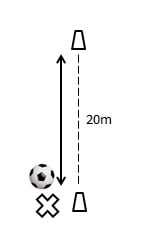
➔ Recommended equipment: 1 ball, 8 cones
➔ Number of players required: 2 players
➔ Set-up: Set up a 30m by 20m pitch using cones to mark the corners. Make two 5m goals at each end line.
➔ Exercise: Players start in the middle of the pitch. (Decide who starts with the ball). Players can only score by stopping the ball on the imaginary line between the goal cones. After a player scores, the other player starts with the ball from their own end line (where the other player scored).
➔ Purpose: With this soccer dribbling drill, practice dribbling with speed and control; practice 1v1 offense and defense; improve physical fitness.
Top 9 shooting and finishing drills
We love football because of all the poetry that surrounds it, but in the end, it comes down to one verse: whoever scores one more goal than the opponent wins. Scoring goals, in professional football, is worth millions. Scoring goals, in any category and in any position, is the best bonus you can give a player. Therefore, here are five exercises to improve shooting. All players on the field should be able to shoot and score, even goalkeepers. When goalies or defenders take corner kicks or join the offense in the attack, defenders often leave the extra players unmarked.
Players who have good shooting skills know how to shoot in stride at different speeds, can shoot the ball from the air or the growd and can shoot with both speed and accuracy. All of which requires a lot of practice. Practice these soccer shooting drills with a friend once or twice a week and you’re sure to improve.
Shot after pass
This is the most basic exercise to train ball striking. One teammate passes the ball to another, who controls it and prepares it for the shot and, with the second touch, shoots at goal. Uncomplicated but fun, especially when you add a competitive component between teammates. This video from OnlineSoccerTraining explains perfectly how to do it.
➔ Exercise level: Easy
➔ Fun rating: 3.5/5
➔ Number of players needed: Minimum of two players and one goalkeeper
➔ Equipment needed: Ball and goal
Because nothing tastes better in football than a goal after a good shot, the kind that clears the cobwebs from the corners of the net.
One-touch shooting
However, on most occasions, the dynamism of today’s football does not allow enough time to control the ball, adapt to it, and hit it. Often, the process must be reduced to a one-touch, first-time shot. And in that, as every football fan knows, the British are the world experts. Every week, the Premier League gives us examples of great first touch goals, from very far away.
So, here is a video from the Reading FC academy on how to train the first touch shot. It’s a simple task, but very convenient for adapting the body and gesture to the first-time shot.
➔ Level of exercise: Easy
➔ Fun rating: 3/5
➔ Number of players needed: One player and one goalkeeper
➔ Equipment needed: Ball and goal
In this sense, regardless of whether to hit one touch, several touches, or a set piece, if anyone can teach any girl or boy how to hit the ball well, it’s Cristiano Ronaldo. This video that we show you here is to be kept in all football schools under the title: “How to hit a football”.
Another example of a great strike is Hakan Çalhanoğlu of Inter Milan, who has one of the most impressive goals ever scored from a free kick while playing for Hamburg.
Three-goal drill
In a twist on the previous methods, combining both driving and one-touch shooting, the three-goal drill can be put into practice. Typical of Chelsea academies, it involves setting up two small goals with defenders and leaving the goalkeeper in a third life-size goal. This video from SocceCoachTV explains perfectly how to carry out the exercise.
➔ Level of the exercise: Medium
➔ Fun rating: 4/5
➔ Number of players needed: Minimum of four outfield players and a goalkeeper
➔ Equipment needed: Ball, goals, and mini goals
Shifting, turning and chest control
With only three players and a goalkeeper, a very dynamic exercise can be carried out, which can be perfectly transferred to the real game. It is a kind of roulette game, in which the player who has just taken the shot must then provide support for a team-mate. The method is explained in this video from ProgressiveSoccer.
The best thing about this exercise is that you can apply all the variations that the coach or player would like allow the ball bouncing, lift it to force a chest control, give a bad pass… the variations are infinite.
➔ Level of exercise: Easy
➔ Fun rating: 3’5/5
➔ Number of players needed: Minimum of three players plus goalkeeper
➔ Equipment needed: Several balls and a goal
And you wonder, is this exercise of any use? Of course, it does, and if not, look at how Spanish legend Vero Boquete is able to score, here, in front of the goalkeeper. Behind that shot, that perfect adaptation of the body, there are numerous roulettes like the one we have shown you.
Headers
But beware, because you do play football with your feet, but not only with them. In fact, in our sport, strategy and stationary play are becoming more and more important, and nothing is as crucial as knowing how to head a shot. To work on this, we bring you a super fun exercise to do in a team, applied by Spanish coach Víctor Sánchez del Amo in his time at Málaga CF.
The method is easy: create a competition between two teams, and each player receives a pass from his teammates who wait in line for their turn. It is entertaining, competitive, dynamic and, as can be seen in the Málaga video, it can be done without goalkeepers.
➔ Level of the exercise: Medium
➔ Fun rating: 5/5
➔ Number of players needed: Six or more, divided into two teams
➔ Equipment needed: Ball and goals
For anyone who wants to be inspired by a header, we think Sergio Ramos is the model to watch out for. The Camas defender does everything right when it comes to finishing: the jump, the tempo, the turn of the neck, the power he puts on the ball… not for nothing is he one of the highest scoring defenders in history, with 102 goals in his 671 appearances for Real Madrid. Amazing.
TOP 25 GOALS Sergio Ramos en LaLiga Santander
More Shooting Drills to practice alone or with a friend
Spain is, along with the Netherlands, the birthplace of pass-and-control football. The famous tiki-taka.
Pass and shoot
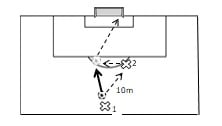
➔ Recommended equipment: 1 ball (a bag of balls is preferable), 1 goal
➔ Number of players required: 2 players
➔ Set-up: Player 2 stands just outside the penalty box. Player 1 stands 10m away from player one with the ball.
➔ Exercise: Player 1 starts with the ball. Player 1 passes the ball to player 2. Player two lays the ball off to player one with a light tap with the inside of the foot. Player two runs to the ball and strikes it into the net (can be one touch or two touches).
➔ Purpose: Practice shooting in stride with this soccer shooting drill.
Agility and shooting

➔ Recommended equipment: 1 ball (a bag of balls is preferable), 1 goal, cones (no set number), 1 training ladder (optional)
➔ Number of players required: 1 player
➔ Set-up: Set up your own agility course using cones and a training ladder (if available).
➔ Exercise: Create your own rules. Here are some ideas: high knees, butt kicks, hopping on one foot, frog jumps, etc. through the ladder. Lunge to touch each cone with your hand. Then, shoot one ball into the net and repeat the agility course.
➔ Purpose: Practice shooting with weak legs. Improve agility and foot speed. Improve physical fitness.
Turn and shoot
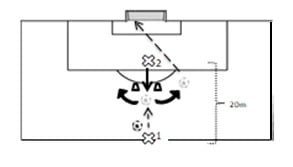
➔ Recommended equipment: 1 ball (a bag of balls is preferable), 1 goal, cones (no set number), 1 training ladder (optional
➔ Number of players required: 1 player
➔ Set-up: Set up your own agility course using cones and a training ladder (if available).
➔ Exercise: Create your own rules. Here are some ideas: high knees, butt kicks, hopping on one foot, frog jumps, etc. through the ladder. Lunge to touch each cone with your hand. Then, shoot one ball into the net and repeat the agility course.
➔ Purpose: With this soccer shooting drill, practice shooting with weak legs. Improve agility and foot speed. Improve physical fitness.
Goalkeeper lob
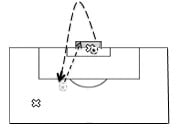
➔ Recommended equipment: 1 ball, 1 goal
➔ Number of players required: 2 players
➔ Set-up: Player 2 stands in goal with the ball. Player one stands somewhere in the box.
➔ Exercise: Player 2 (the goalkeeper) starts with the ball and throws it high into the air. Player 1 must either shoot with a single touch, or control the ball (with one or two touches) and then shoot.
➔ Purpose: With this soccer shooting drill, practice shooting high and bouncing balls; improve one touch and two-touch shooting; improve timing.
Top 9 passing & control drills in football
Spain is, along with the Netherlands, the birthplace of pass-and-control football. The famous tiki-taka, whose precursor was Johan Cruyff and was taken to excellence by Pep Guardiola’s Barça, in which four artists of its interpretation such as Iniesta, Xavi, Messi and Busquets joined forces. Here are the five best exercises that you can use to continue, on your own, with this style.
Ball control refers to a player’s ability to collect the ball and gain control of it using all parts of the body including feet, legs, chest, and head. A player with good ball control is able to receive passes both on the ground and out of the air with clean first touches keeping the ball close to their body. Ball control is important both for winning and maintaining possession. These soccer ball control drills are designed not only to improve your ability to control the ball.
Basic short passes
To start working on passing accuracy and intensity, nothing like a classic exercise between three teammates. It’s all about control and short pass to one side, control, and short pass to the other. The foot surface that is usually worked on here is the inside, but you can extend the distances and also use the outside or the instep. This video from Progressive Soccer explains perfectly how this exercise works.
➔ Level of the exercise: Easy
➔ Fun rating: 3/5
➔ Number of players needed: Three players
➔ Equipment needed: Ball
The “rondos”
The problem with the previous exercise is that, although it helps to gain confidence with the ball, it is not much fun, nor does it put the players in tight situations. For that, there is nothing like the sacred exercise of ‘tiki-taka’, the one that Guardiola introduced in the historic Barça of the Six Trophies as a religion: the ‘rondos’. All you need is a few cones and, as you can see in this video, laughs are guaranteed.
➔ Exercise level: Medium
➔ Fun rating: 4.5/5
➔ Number of players needed: Minimum of six players
➔ Equipment needed: Ball and cones
The practical application of this exercise is more than clear. Just look, for example, at the way Pep Guardiola’s current team, Manchester City, plays. A world-class football symphony.
The long pass
When the opposing team is playing in the part of the pitch where the ball is, or when they are playing with a very advanced defense, there is nothing like the art of the long pass to break them down. A single long pass can undo the best defense in the world, and a great exercise is this one by Profe Bazan.
Furthermore, the work is twofold with this method: the passer practices the long pass, but the receiver improves his ability to control and shoot. Two for one.
➔ Exercise level: Medium
➔ Fun rating: 3’5/5
➔ Number of players needed: Two players and a goal
➔ Equipment needed: Ball and goal
Probably no one has ever mastered precision long passing combined with excellent vision the way Xabi Alonso, former Spain national team, Real Sociedad, Liverpool, Real Madrid and Bayern Munich player, did. What he did was crazy.
The deep pass
Working the deep pass is not easy. First, because performing filtered passes through a defence requires a lot of peripheral vision, a lot of understanding of the game, and the quality to execute the ball at the right speed and through the right space. To practice this last part, we think a great idea is this one from The Football Clinic in this video:
Although it is not optimal, the fictitious defenders can be replaced by cones, and with them you can represent the positions of a defence between which you have to filter passes.
➔ Level of the exercise: Difficult
➔ Fun rating: 4/5
➔ Number of players needed: Minimum of four players
➔ Equipment needed: Ball and dummies/cones
A master of the deep pass – and so many other things – is Spanish player Alexia Putellas, a double Ballon d’Or winner, as well as the star of FC Barcelona and the Spanish national team. Here’s a compilation of her best moves, including a few out-of-this-world passes into space.
Control and passing
To work on the science of passing with one or two touches maximum, a basic pillar of the positional play of the teams of the school of football created under the wing of Johan Cruyff, we bring you one of the players who has interpreted it best in recent years: Sergi Busquets. Three exercises in one to improve control and passing in this Fútbol Emotion video
➔ Level of the exercise: Easy
➔ Fun rating: 3/5
➔ Number of players needed: One (plus a passer)
➔ Equipment needed: Ball and cones
More Passing & Control Drills to practice alone or with a friend
Keep it in the cones
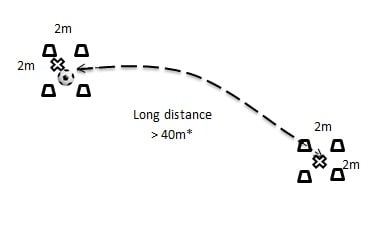
➔ Recommended equipment: 1 ball, 8 cones
➔ Number of players required: 2 players
➔ Set-up: Use the 8 cones to set up two boxes (2m x 2m) at a far distance. *Distance will depend on skill and strength of players. Players should be able to pass the ball to each other using about 60-70% of their strength.
➔ Exercise: Players pass back and forth keeping the ball within their own square space. Practice with both feet.
➔ Purpose: This soccer ball control drill helps improve accuracy, improve ball control, slight strength training, practice concentration.
Receiving throw-ins

➔ Recommended equipment: 1 ball, 2 cones
➔ Number of players required: 2 players
➔ Set-up: set up two cones 10m apart. Receiving player starts at the cone farthest from the thrower.
➔ Exercise: In this soccer ball control drill, players practice receiving light, controlled throw-ins from their partners. Receiving player passes back to the thrower with one touch or two touches. Receiving player must check to the closer cone in order to receive the ball. Thrower begins with ground balls to the right foot and then the left, then, throws so the receiver can volley back with the inside of each foot. The thrower continues to throw to his or her partner’s thighs, then chest, then head. Thrower should throw to each body part 5-10 times before switching.
➔ Purpose: Improve ball control using various body parts.
Receiving corner kicks
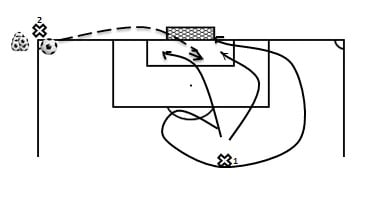
➔ Recommended equipment: 1 ball (a bag of balls is preferable), 1 goal.
➔ Number of players required: 2 players.
➔ Set-up: Player 2 stands at a corner with a ball (bag of balls). Player 1 stands at the top of the box.
➔ Exercise: Player 2 takes corner kicks. Player 1 runs various routes toward the net and attempts one-touch or two-touch shots.
➔ Purpose: Practice controlling balls in the air; practice shooting in stride; corner kick practice with this soccer ball control drill.
Juggle
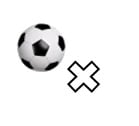
Top 4 defense drills in football
Lastly, let’s move on to what 80% of players might not like the most, but which must be learned nonetheless: defensive concepts and technique. Because as they say in basketball, attack can win games, but defense wins championships.
Organising pressure
Pressure is the most important element in football today. Every team knows how to press their opponents in the opposition half, in the middle of the pitch or even close to their goal. The secret lies in knowing how to cover passing lanes, maintain structure and perform a series of coordinated movements that make it difficult for the opposition to move the ball.
To prepare for all this, in an exercise that is aimed above all at the collective, The Coaching Manual brings us this exercise to instil the basic concepts of pressure through the coverage of passing lines. A basic one.
➔ Recommended equipment: 1 ball
➔ Number of players required: 1 player
➔ Set-up: none required
➔ Exercise: Player attempts to keep the ball in the air using feet, legs, chest, and head.
➔ Purpose: Improve general ball control. Beginner jugglers should first try with their thighs.
➔ Exercise level: Medium
➔ Fun rating: 3’5/5
➔ Number of players needed: Minimum of 10
➔ Equipment needed: Ball, cones and dummies
Which team has been the best at pressing in recent years? Jürgen Klopp’s Liverpool, for sure. They put on a show of physicality to disrupt their opponents’ possession.
Defensive resources and posture
Here, as defensive resources, we must differentiate between regular attack and tackling. In the first, which could be any move to steal the ball from the opponent, it is not necessary to go to the ground. Tackling, on the other hand, is that movement in which the defender, as a last resort, crawls across the turf to scratch the opponent’s ball.
It is difficult to find videos of specific exercises for either of them. Perhaps the smartest thing to do is to look for lessons on defensive fundamentals and put them into practice by combining them with the 1-on-1 drills mentioned at the beginning of the article. For instance, in this regard, one of the most useful videos to explain the optimal posture of a defender is this one of Real Madrid center-back Eder Militao, on Fútbol Emotion.
What is explained there can be put into practice with our 1-on-1 drills, the characteristics of which we leave you here again:
➔ Exercise level: Easy
➔ Fun rating: 4/5
➔ Number of players needed: At least 2
➔ Equipment needed: Ball and objects of any kind to mark out a goal
Tackling
Something similar happens with tackles, where the defender slides along the floor to steal the ball. There is no specific drill, but it is best practiced using the classic 1-on-1 method.
However, if you must choose a reference point for this, the example to follow should be the AC Milan legend and former captain of the Italian national team, Alessandro Nesta. A legend of the best rear-guard in the world, pure class and owner of the best tackles ever seen.
Defensive clearance with head
As important as heading in attack is in nowadays football, so is defensive heading: a team whose defense does not have a good aerial game is condemned to perish against strong teams up front.
In this regard, the exercise proposed by SoccerCoachTV is perfect for training this discipline. First, because it is fun, and it is almost a game in which the participants can enjoy themselves. Secondly, because it forces them to internalize the key concepts of a good defensive head clearance: altitude, width, and strength.
The game is a sort of volleyball where, instead of a net, there are two players trying to intercept the ball. The player who misses and sees his clearance intercepted will play the role of the net.
➔ Level of exercise: Medium
➔ Fun rating: 5/5
➔ Number of players needed: Minimum of three, but ideally six.
➔ Equipment needed: Ball
Playing in small spaces
Finally, an excellent way to put into practice what has been learnt in the 19 exercises mentioned above are the games in small spaces. Why? Well, because everyone will have to apply all these techniques, as the defenders will not only defend, and the forwards will not only attack.
Moreover, by playing in small spaces, everything will be more dynamic, with many more actions, and without any pause. A wonderful way to round off a training session.
➔ Level of the exercise: Difficult
➔ Fun rating: 5/5
➔ Number of players needed: Minimum of ten, including goalkeepers
➔ Equipment needed: Ball and goals
More Defensing Drills to practice alone or with a friend
Playing in small spaces
Finally, an excellent way to put into practice what has been learnt in the 19 exercises mentioned above are the games in small spaces. Why? Well, because everyone will have to apply all these techniques, as the defenders will not only defend, and the forwards will not only attack.
Moreover, by playing in small spaces, everything will be more dynamic, with many more actions, and without any pause. A wonderful way to round off a training session.
➔ Level of the exercise: Difficult
➔ Fun rating: 5/5
➔ Number of players needed: Minimum of ten, including goalkeepers
➔ Equipment needed: Ball and goals

